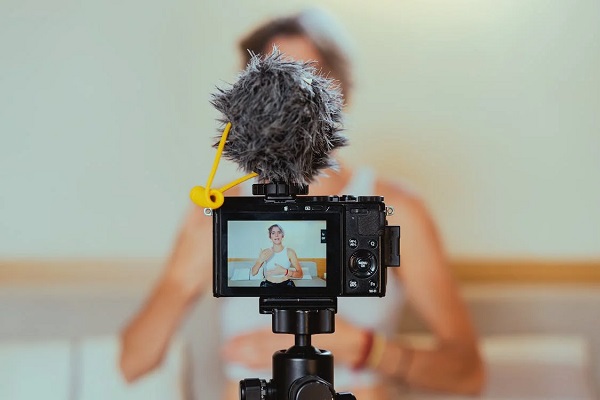How to do successful live streams: 21 Tips for beginners
If you’re taking your first steps into the world of live video streaming, then check out this article the 21 best tips on how to do successful live streams on the Internet.
You may have noticed that live broadcasts on Instagram, Facebook, and other social networks have become increasingly common online. However, what few know is that there are several important tips on how to succeed with quality streams on social media.
To do a successful live stream, it is necessary to choose some of these 4 broadcasting tools, which are among the best available on the market:
If you’re taking your first steps into the world of live video streaming, then check out the 21 best tips on how to do successful live streams on the internet.
Best tips for doing a live stream
With the resources and tools found on social media today, going live on the internet is very simple. However, to do successful live streams, it is essential to be aware of some tips that can make all the difference in your stream.
An important tip for those who are starting to do live streams is to find a quiet environment, in order to avoid unwanted surprises, such as dogs barking or people interrupting you during the stream.
To help you make amazing broadcasts on Facebook Live or any other platform, we’ve put together these 21 tips on how to do successful live streams. Keep reading and learn how to become a great live content presenter.
1. Choose a good streaming tool
Starting our selection of tips on how to do successful live streams, let’s talk about platforms. The first step in going live is choosing a good live-streaming tool. There are currently 4 platforms that are considered the best in the industry:
This platform is incredibly intuitive and easy to use. Just create an account, link it to your Facebook, Youtube, or other social media account, and then you’ll be ready to start your streams.
With this popular live-streaming platform, it is possible to make simultaneous broadcasts to several social networks. In addition, it offers compatibility with external software, such as Zoom and OBS, making it easier to carry out your live streams.
With several features, Be.Live makes it possible to highlight important questions, making your stream much more visually attractive. It is also possible to share your screen, which will help in the case of classes or corporate meetings, or even gaming live.
Onestream’s biggest strength is its ability to stream live on over 40 platforms simultaneously. The user can start making lives in a few minutes, without the need for complicated settings or any technical knowledge.
2. Invest in a reliable internet connection
If there’s one thing that no one tolerates on social media, it’s watching a live stream that keeps on lagging and crashing. For this reason, investing in a reliable internet connection is essential to ensure the stability of a live stream.
In addition to choosing a reliable and well-recommended internet provider, it is important to note that these companies offer high-speed plans such as 750 or 1000 megabits per second, however, they often do not make it clear that these speeds refer only to the download rate. However, for live streaming, what you need is a good upload speed.
The upload speed is the speed at which files and data gets uploaded from your device to the internet. Therefore, one of the main points to pay attention to when choosing an internet provider is the upload speed offered, as many operators offer plans with high download rates, but with upload rates up to 10 times lower.
Finally, it’s important to consider the technology used, as choosing fiber optics is ideal. That’s because fiber is much more reliable, stable, and usually faster at a lower price.

3. Get quality equipment
To ensure the success of a live stream, it is essential that your viewers can clearly hear what is said, and see what you’re broadcasting clearly, in high definition.
A good quality microphone can reproduce your voice in a natural and crystal clear way, making it easier to understand for those listening to you. On the other hand, poor-quality microphones can result in muffled and lifeless audio or excessively high-pitched and squeaky audio.
The camera can even be a smartphone, as long as your device is a brand and model recognized for its video-recording quality. However, if your phone does not have a good enough camera, you can opt for one of the best webcams for live streaming.
Other equipment that, although not mandatory, can help improve your live broadcasts are tripods, lighting, reflectors, and headphones, among others. It is important that all this equipment is of good quality so that you get the best result in your streams.
4. Have a good-looking environment
Continuing with our list of tips on how to do successful live streams, let’s focus now on the scenario. Live streams held in environments with a scenario specially planned for the transmission usually have a better visual result and offer a more interesting experience for those who are watching.
Often, the simple combination of a chair, a table, and an interesting background wallpaper can be enough to create a beautiful backdrop for your live streams. However, this composition can be enriched by placing objects on the table and a boshelf with decorations in the background.
Avoid doing lives with your bed or bedroom closet in the background, which can convey an excess of informality. Your audience feels valued when they see that you’ve dedicated yourself to creating a special environment to interact with them.
5. Set your streaming style
If you usually follow live streams on social media, you must have noticed that there are different ways and styles to carry out live streams. Thanks to this variety, each content creator can pursue a unique approach to captivating their audience.
There are streams with educational content, where something is taught; chat streams, where you can exchange ideas with your audience; broadcasts with interviews, where you will receive interesting guests; vlog style live streams, where you will show things from your day-to-day; plus many other styles.
When choosing a style for your streams, it is essential that you identify with it and feel confident in carrying it out. That way, you’ll give your viewers a more authentic and natural impression.
6. Organize the content in a script
One of the most common concerns for those just starting out in the world of live streaming is the possibility of getting lost, forgetting some topics they were going to address, or worse, going completely “blank” and forgetting everything they wanted to talk about.
Therefore, one of the most important tips on how to do successful live streams is to make a script with the main topics you want to develop during your stream. This organization of ideas will ensure that your content has a logical sequence, with a beginning, a middle, and an end, in addition to avoiding forgetfulness and unnecessary repetition.
When interviewing someone, although it is possible to improvise and ask questions based on the guest’s answers, you will certainly feel more confident if you have already prepared at least ten questions about the person in question.
Have you already chosen which platform you will perform your streams on? So understand what Twitch is and how to use it for streaming!
7. Rehearse before doing it for real
To carry out a successful live stream, it is essential that you transmit your content to viewers in a way that conveys security and authority, which can often be difficult for someone who is still starting out and has no experience in this medium.
An easy way to improve your speaking skills is by recording videos as a rehearsal or test. Thus, you will be able to evaluate your performance and correct possible errors before going live for real.
When recording rehearsal videos, pay attention to all the details, such as posture, movement, gestures, facial expression, and enunciation, among many other details that can make your live broadcast a real success.
8. Find a peaceful environment
There are countless videos on the internet with unusual scenes that happen during live streams, such as unwanted noise caused by dog barking, ambulance sirens or hammering on the wall, and even relatives screaming your name or suddenly invading your stream.
To avoid these or even worse embarrassments, look for a reserved and quiet place, so you can fully focus on your content, without distractions. The best location should be the quietest in the house and the one with the best acoustics, or the greatest distance from undesirable sound sources.
Another important point is to explain to your relatives or other residents of the house the importance of keeping silent and not interrupting during live broadcasts, ensuring a suitable environment for quality live streams.

9. Do the stream on several platforms
Continuing with our compilation of tips on how to do successful lives, let’s talk about audience and engagement, which are everything for those who do lives. To gain a loyal following base, it is important to maximize the reach of your live broadcasts.
By broadcasting your stream on different platforms, you significantly expand the reach of your broadcasts and have the possibility of reaching different audiences, resulting in greater engagement and more people interested in your upcoming content.
Further, broadcasting in different spaces can also increase interaction with the audience, due to the presence of chat systems on each platform, which facilitates the interactivity of viewers who are watching your broadcast.
10. Enrich your live stream with graphic elements
If you want to make your broadcast more attractive and visually interesting for the audience, it is important to add graphic elements and effects to your live stream.
A presentation enriched with visual elements turns out to more easily capture the attention of viewers, after all, it is much easier to keep an eye on dynamic and moving content.
In addition, the use of graphic elements such as images, video scenes, slides, and graphics, helps to convey your message clearly, making it easier for the audience to understand and retain the content presented.
11. Be ready to deal with setbacks
In a live stream, anything can happen, including nothing, like the times when the person starts an interview live, but their guest is unable to connect. This can be easily resolved if the respondent learns how to ask to participate in a live on Instagram. However, many other incidents and surprises can happen in live streams, such as interruptions, accidents, technical problems, and provocations by haters in the chat, among others.
In case of eventualities or accidents during a stream, keep calm and clearly explain to the public what is happening, apologizing if necessary.
If the setback is of technical origin, it is important to quickly assess whether the problem presented can be tolerated by the public or whether the event calls for the end of your stream. Microphones with broken sound, image crashes, and audio delays can be good reasons to reschedule the stream for a new occasion.
12. Set your live time
Establishing the time of your live stream is important for you to plan ahead with the content you want to present, ensuring that all information will be passed on more or less in the time you determined.
Very short live broadcasts can be insufficient to explore all aspects of the subject and can leave the content too shallow or poorly explained for those who are watching. On the other hand, streams that are too long can become tiring and repetitive, causing viewers to lose interest before the end.
Try to determine the length of your stream according to the content you want to transmit and the target audience that will watch it, taking care not to make it too short or too long.
13. Publicize your stream in advance
How many times have you missed live broadcasts of interesting content simply because you didn’t know when that live stream would happen, or that it even existed? Therefore, publicizing a stream in advance is important for you to attract a significant and engaged audience to your broadcast.
One of the ways to promote your live stream is through your social media, asking friends and family to help share your post. In addition, you can also promote your live stream on other channels such as websites, blogs, and email inboxes.
The more you publicize, the greater the chance of attracting the attention of an audience interested in the subject you will address.
14. Choose a time with the highest audience
Each audience has a specific behavior regarding the times of use of social networks, and it is important to take this into account when choosing the time for your live stream.
For example, children and teens may have a significant presence on social media throughout the day, while adults who work office hours may be most active during their lunch break and into the evening.
When choosing a time for your live broadcast, take into account your target audience and what possible times they should be more present on social networks or on the platform where you intend to do your live, so you increase the chances of success of your broadcast.
15. Spark interest with an eye-catching headline
Moving forward with our list of tips on how to do successful live streams, let’s talk about its title. A catchy phrase can play a significant role in attracting an audience to your stream. With the proper title choice, it is possible to attract the attention of both people interested in the subject you will address in the stream, and curious people, who clicked just because they were attracted by the title you created.
When creating a title for your live stream, you can either make it clear what it is about, to give the public a preview of the content they will watch, or you can create a more mysterious and enigmatic title, leading them to click on the live only to find out what it is.
Ahhh, and most importantly: pay attention to your grammar! Titles with grammatical errors tend to be less clicked than those written obeying all the rules of your language.
16. Create an engaging description
Just like the title of the stream, the description of the video is equally important, as it provides your audience with a richer experience with additional information about the content of the live strean that they watched. A well-crafted description helps increase your viewer’s retention and engagement.
It is in the video description that you have the opportunity to make sales related to the content of your live stream, such as courses, mentorships, services, or products. This space is also the ideal place to promote your other social networks, increasing and strengthening your follower base.
However, it is important to familiarize yourself with the rules of the platform where you broadcast your live streams, to understand, for example, whether it is allowed to promote products or promote other external networks.
Once you’ve written a creative description for your live stream, check out some of the best live streaming apps.
17. Set a schedule for your live streams
There’s nothing better than arriving on a certain day of the week and knowing that, at a certain time, content you love will be broadcast, right? This is called periodicity, which is the time interval between live broadcasts of a given content.
The main effect of having a periodicity for producing content is increased engagement since a person who watched your content has a greater chance of always being available on that day of the week and time to follow your future live streams.
When viewers stick with the day and time you go live, they tend to become more loyal to your channel as they see that you are committed to providing content on a regular basis.

18. Interact and encourage public participation
Interacting and encouraging audience participation is important to do successful live streams, so you create a greater connection with your followers, making the experience of those who watch it as interactive as possible.
During the live stream, you can ask viewers questions, respond to their comments and questions, promote polls, request support through likes, thank them for participating, and explore many other ways to interact.
The feeling of belonging is one of the main factors that drive engagement. In this way, viewers appreciate having their participation and time dedicated to the content, recognized by those who produce it.
19. Show gratitude to viewers
Showing gratitude to viewers is very important, as it helps create a positive atmosphere for your audience and strengthens your bond with them, making them feel close to you.
Additionally, this attitude of gratitude also contributes to audience engagement, as viewers are more motivated to engage and share your content when they feel recognized and appreciated.
Another important point is, in addition to showing gratitude to those who attend, to respond calmly and politely to questions from the public, even those who talk inappropriately. This improves your reputation in relation to the public, as it denotes humility, empathy, and respect for those who follow your streams.
20. Study your presentation for future improvements
While some people may find it uncomfortable to watch themselves or hear their voices in a live stream after it has ended, this is one of the most important tips for improving your presentations during live streams. By watching yourself, you’ll quickly identify your presentation’s strengths and weaknesses and discover exactly what needs improvement.
Therefore, analyzing your performance during these broadcasts can reveal valuable information about what can be improved in your presentation in future broadcasts.
Another important point is knowing how to listen to the public’s criticism, even the less constructive ones, as they can also offer significant opportunities to improve your work in future live broadcasts.
21. Monitor your live performance
To finish our selection of tips on how to do successful live streams, we have the follow-up. Most platforms and social networks where you can broadcast live provide a variety of data and statistical information that reveal the performance of your live stream during and after the broadcast.
This data, which is not always public, include the number of viewers when you were live, the average duration of viewing time, engagement through likes, and the number of comments and shares.
By analyzing this data, you can better understand your audience’s interests and preferences, as well as identify the types of content that attract their attention and generate engagement.
Main questions about lives
What does it take to do live streams?
First, follow our tips on how to do successful live streams. However, to perform a quality live stream, in the beginning, you only need a smartphone and a good internet connection. Using your phone camera you can make simple transmissions.
What’s the best way to go live?
To start, do detailed research on your target audience’s behavior to determine the best day and time to broadcast. Then, choose a format that you have an affinity with and get to work, and start creating your live streams.
What can’t be missed in a live stream?
Having good equipment, such as a quality camera and a good microphone, is essential to guarantee professional quality in your live broadcasts. But equally important is your internet, which must have a stable connection and high a upload speed.
What are the best platforms to do live streams?
Currently, the best platforms on the market to do live streams are:
These video platforms were developed to meet the needs of content creators and companies looking for fast service with advanced features.
Ready to do your first live stream?
We sure are! By following these successful live-streaming tips, you’ll be fully prepared to do successful live streams. Now, just muster up some courage and start making your first broadcasts!





